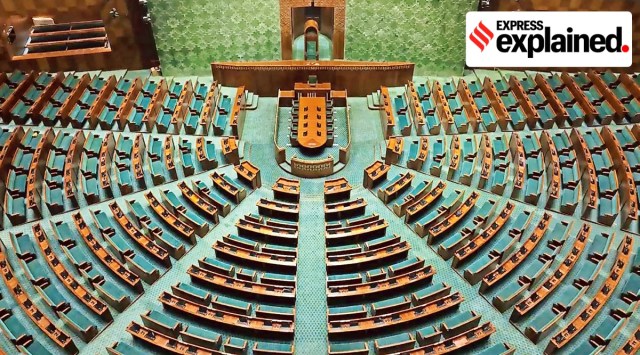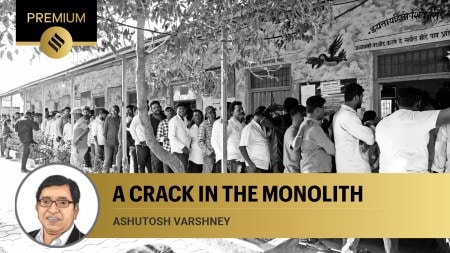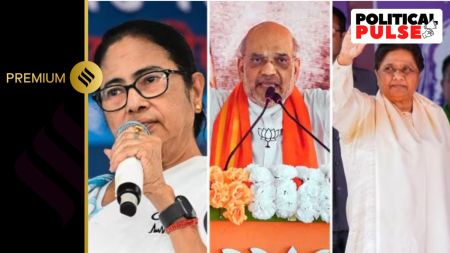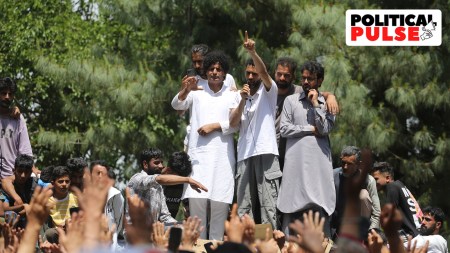- India
- International
India’s new Parliament, and why it is needed
What are the salient features of the new building inaugurated on May 28? How much bigger and more efficient than the iconic but increasingly obsolete and dangerous old Parliament House is it?
 Ad hoc constructions and modifications have been made over time, and the building “is showing signs of distress and over-utilization and is not able to meet the current requirements in terms of space, amenities and technology”. (PTI)
Ad hoc constructions and modifications have been made over time, and the building “is showing signs of distress and over-utilization and is not able to meet the current requirements in terms of space, amenities and technology”. (PTI)
In the 75th year of Independence, India has a new Parliament building, built by Indians, and embodying the culture, pride and spirit of the entire nation. Here’s what to know about the new building.
Why does India need a new Parliament building?
The official website of the Central Vista project makes the point that the existing Parliament House, which was commissioned in 1927, is almost a century old Heritage Grade-I building that has seen a massive increase in parliamentary activities and users over the decades.
Ad hoc constructions and modifications have been made over time, and the building “is showing signs of distress and over-utilization and is not able to meet the current requirements in terms of space, amenities and technology”.
Some of the major issues, according to the official website, are:
* Narrow seating space for MPs: The present building was never designed to accommodate a bicameral legislature for a full-fledged democracy. The number of Lok Sabha seats is likely to increase significantly from the current 545 after 2026, when the freeze on the total number of seats lifts.

“The seating arrangements are cramped and cumbersome, with no desks beyond the second row. The Central Hall has seating capacity only for 440 persons. When the Joint Sessions are held, the problem of limited seats amplifies. Due to limited space for movement, it is also a huge security risk,” says the official site.
* Distressed infrastructure: The addition of services like water supply and sewer lines, airconditioning, firefighting equipment, CCTV cameras, etc., have led to seepage of water at several places and impacted the aesthetics of the building. Fire safety is a major concern at the building, the official site says.
* Obsolete communication structures: Communications infrastructure and technology is antiquated in the existing Parliament, and the acoustics of all the halls need improvement.
* Safety concerns: The current Parliament building was built when Delhi was in Seismic Zone-II; currently it is in Seismic Zone-IV, says the website. This raises structural safety concerns.
* Inadequate workspace for employees: Over the years, inner service corridors were converted into offices which resulted in poor-quality workspaces. In many cases, these workspaces were made even smaller by creating sub-partitions to accommodate more workers.
What are the main features of the new Parliament building?
The official website says the new building, which stands alongside the existing Parliament House, “reflects the aspirations of 135 crore Indians”. The old and new Parliament buildings “will work together as an ensemble” to “facilitate smooth and efficient functioning of operations”.
The official website lists the following salient features of the new Parliament:
* It has a built-up area of about 65,000 sq m, with its triangular shape ensuring the optimum utilisation of space.
* The new building will house a larger Lok Sabha hall with a capacity of up to 888 seats, and a larger Rajya Sabha hall with a capacity of upto 384 seats. The Lok Sabha may accommodate up to 1,272 seats for joint sessions of Parliament.
* The Lok Sabha hall is based on the peacock theme, India’s national bird.
* The Rajya Sabha is based on the lotus theme, India’s national flower.
* A state of the art Constitutional Hall in the building “symbolically and physically puts the Indian citizens at the heart of our democracy”, says the official website.
* The building will have ultra-modern office spaces that will be secure, efficient, and equipped with the latest communications technology.
* The new building will have large committee rooms with the latest audio-visual equipment, and will provide a superior library experience.
* A “Platinum-rated Green Building”, the new Sansad Bhavan will embody India’s commitment towards environmental sustainability, according to the website.
* The building will be an embodiment of Indian heritage, reflecting the “vibrance and diversity of modern India, incorporating our cultural and regional arts and crafts”.
* The new Parliament will be divyang friendly, and people with disabilities will be able to move around freely, says the website.
* A Central Lounge that will complement the open courtyard will be a place for members to interact with each other. The courtyard will have a banyan, the national tree, says the website.
More Explained
EXPRESS OPINION
May 20: Latest News
- 01
- 02
- 03
- 04
- 05







































